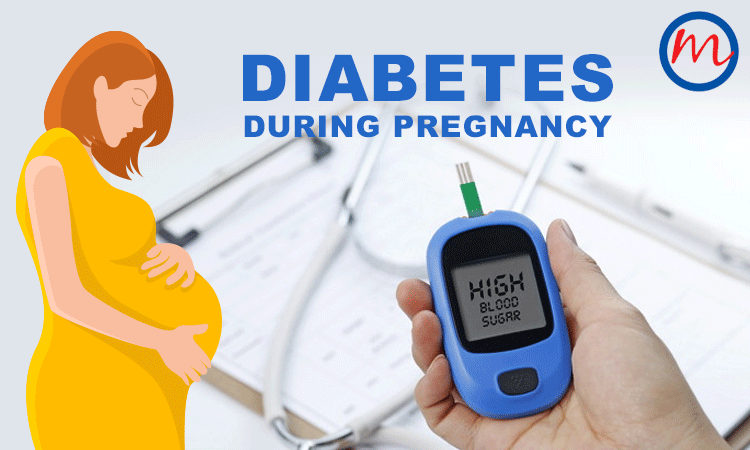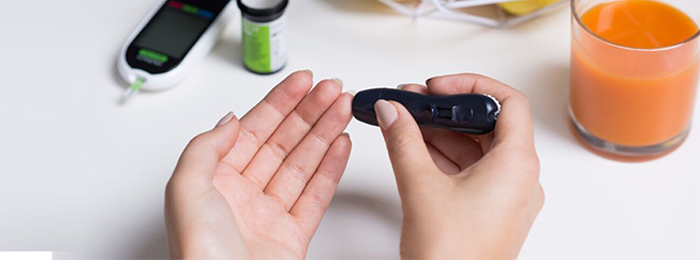Dr. Bhavadharini Balaji & Dr. V Mohan
During pregnancy, placenta gives nutrients and oxygen for the baby. The placenta also makes other hormones. During later part of pregnancy, certain hormones produced by the placenta can block insulin. When insulin gets blocked, its called insulin resistance. This leads to glucose staying in the blood and not getting utilized by the body. This is called as hyperglycemia (or high levels of sugar in the blood).
Types of diabetes during pregnancy
Some women have diabetes even before they get pregnant and this type is called pregestational diabetes. These women have either type 1 or type 2 diabetes much early in life. There are some women who develop diabetes for the first-time during pregnancy and this is called as gestational diabetes mellitus (GDM).
Gestational diabetes mellitus (GDM)
Ten to twenty percent of pregnant women in India develop GDM during pregnancy. A prevalence study conducted by Madras Diabetes Research Foundation, the research wing of Dr. Mohan’s Diabetes Specialities Centre, reported prevalence of GDM to be 19.8% in urban Chennai (1).
Who are at risk for GDM?
There are several risk factors for developing GDM during pregnancy:
- Overweight: If your weight is more or your BMI is high, then this is one of the most important risk factors for gestational diabetes during pregnancy. The extra weight affects the insulin’s ability to keep blood sugar levels under control.
- Abdominal fat. If you have higher levels of abdominal fat in the beginning of your pregnancy, then that puts you at a risk of developing gestational diabetes as pregnancy advances.
- Age: If you are 25 years of age or more, then you have a strong risk for developing gestational diabetes.
- Family history: If one or both of your parents have diabetes, then you are at a higher risk.
- Previous pregnancy with GDM: if you had GDM in your previous pregnancy then that puts you at a higher risk of developing GDM again.
| . Age ≥25 years . BMI ≥23kg/m2 . High risk ethnic groups – South Asian . Previous history of GDM . Family history of type 2 diabetes . History of poor obstetric outcomes – congenital malformations, still birth etc |
How does GDM affect the baby?
If GDM is not properly managed during pregnancy, all the sugar in the blood will bypass the placenta and will go straight to the baby. High blood sugar levels in the mother will make the baby grow larger than normal (called as macrosomia). If blood sugar in the mother is not controlled properly, it can also lead to still birth. Other risks include early delivery, high blood pressure in the mother. For the baby, there can be other complications like low blood sugar at birth and jaundice. These are some of the short-term complications. In the long term, children of mothers with GDM are at a higher risk of developing obesity, insulin resistance, type 2 diabetes and cardiovascular disease later in life. A retrospective research study conducted by by Madras Diabetes Research Foundation and Dr. Mohan’s Diabetes Specialities Centre, studying the pregnancy outcomes of women with GDM in Chennai, showed that women with GDM had higher rates of caesarean section, preeclampsia and macrosomia when compared to women without GDM (2). Subsequently, the WINGS study conducted by Madras Diabetes Research Foundation, tested a comprehensive low-cost model of care for women with GDM. The results from this study showed that women with GDM who were regularly followed up every 2 weeks during pregnancy, had similar pregnancy outcomes as those without GDM, highlighting the importance of proper care and follow up during pregnancy (3).
Knowledge about GDM among pregnant women in Chennai:
Improving health literacy helps the individual to comprehend and adopt a healthy lifestyle. The challenge, however, is that managing GDM requires women to come to terms with their diagnosis in a short period of time. Therefore, building health literacy skills and knowledge that is required to understand the importance of screening and managing GDM, within this short window period, is sometimes challenging.
Knowledge is an important component of health literacy. Studies show that inadequate knowledge about the disease leads to poor understanding of medical information. This leads to limited adherence to management strategies and ultimately unfavourable pregnancy outcome. In the Indian context, several cultural factors also play a very important role in health-seeking behaviour, especially amongst pregnant women. At Madras Diabetes Research Foundation and Dr. Mohan’s Diabetes Specialities Centre, a study (4) was conducted to evaluate the knowledge of GDM among pregnant women in urban Chennai and rural Kanchipuram. The results showed that nearly 50% of women in both urban and rural areas were unaware of any risk factor for GDM. Over 75% of rural women did not know the long-term consequences of GDM. Over 50% of women in both urban and rural areas were not aware that GDM could lead to type 2 diabetes in the future. This highlights the need for teaching the public about GDM.
How will I know if I have GDM?
Most women do not have any obvious symptoms, because, some symptoms like extreme hunger, thirst, or fatigue are also common during normal pregnancies. Therefore, unless you do a proper screening, you wouldn’t know if you have GDM or not. At Dr. Mohan’s Diabetes Specialities Centre, pregnant women are referred by their gynecologists if they detect any glucose abnormality or detect any risk factor for GDM.
When should I get tested for GDM?
All pregnant women should be ideally screening at the first antenatal visit. Screening in early pregnancy is usually done using fasting plasma glucose, or glycosylated haemoglobin (commonly referred to as HbA1c), or random plasma glucose (RPG). Doing this test early in pregnancy will help identify any abnormality in glucose which the women probably did not know about.
If during early pregnancy, the test comes back as normal, then women should undergo repeat testing between 24-28 weeks using an oral glucose tolerance test. This test is usually done in fasting state. At Dr. Mohan’s Diabetes Specialities Centre, women are asked to come in fasting state atleast 8 to 10 hours. Fasting blood sample is collected and 350ml of glucose drink is given to drink. One hour and 2 hour after the glucose drink, blood sample is drawn again. If fasting plasma glucose is between 92-125mg/dl or 1 hr of glucose load >180mg/dl or 2 hrs level is >153mg/dl the woman is said to have GDM.
Can this test be done in non-fasting state?
The International Association of Diabetes and Pregnancy Study Group (IADPSG) recommends that the women be tested for GDM using oral glucose tolerance test in the fasting state. A research study conducted at Madras Diabetes Research Foundation showed that doing the test in non fasting state does not satisfactorily identify all the women who have GDM when compared to the IADPSG recommended test in the fasting state (5). Therefore, it is essential that women who have GDM be correctly diagnosed using the right testing process to ensure a healthy pregnancy and healthy baby.
I have heard that gestational diabetes goes away on its own, then why should I be worried?
One of the most common misconception is that if you get diabetes during pregnancy, it will go away after delivery and therefore there is no need to worry. Unfortunately, this is not always true. Half the women who have gestational diabetes during pregnancy have an increased chance of developing type 2 diabetes within a few years after delivery. This is why, it is important for all women with gestational diabetes to undergo repeat screening for diabetes 6 weeks after delivery to see if the blood sugars have come back to normal. A study conducted at Dr. Mohan’s Diabetes Specialities Centre and Madras Diabetes Research Foundation showed that among women with GDM who came for follow up after delivery, 60% of them developed diabetes within 5 years and by 10 years, most women had converted to diabetes. This study emphasizes the need for prevention and developing an evidence-based cost-effective approach to manage GDM (6). The WINGS study (7) also showed that 15.5% of women with GDM developed dysglycemia 12 weeks after delivery and 38% developed before 1 year after delivery. All this data only highlights the importance of repeat screening and why women who have had GDM should come back every year after delivery to check their blood sugar levels.
Watch out for our next article where we will discuss
- Managing Gestational Diabetes
- Guidelines for healthy eating
Carbohydrate counting
- Physical activity
- Weight gain during pregnancy
- Insulin administration and blood sugar monitoring
Click here to access FREE GDM Ebook
Snake and Ladder Game English Version
Snake and Ladder Game Tamil Version
Snake and Ladder Game Hindi Version
References
- Bhavadharini B, Mahalakshmi MM, Anjana RM, et al. Prevalence of Gestational Diabetes Mellitus in urban and rural Tamil Nadu using IADPSG and WHO 1999 criteria (WINGS 6). Clin Diabetes Endocrinol. 2016;2:8. Published 2016 Apr 5. doi:10.1186/s40842-016-0028-6
- Mahalakshmi MM, Bhavadharini B, Maheswari K, et al. Comparison of maternal and fetal outcomes among Asian Indian pregnant women with or without gestational diabetes mellitus: A situational analysis study (WINGS-3). Indian J Endocrinol Metab. 2016;20(4):491-496. doi:10.4103/2230-8210.183469
- Uma R, Bhavadharini B, Ranjani H, et al. Pregnancy outcome of gestational diabetes mellitus using a structured model of care : WINGS project (WINGS-10). J Obstet Gynaecol Res. 2017;43(3):468-475. doi:10.1111/jog.13249
- Bhavadharini B, Deepa M, Nallaperumal S, Anjana RM, Mohan V. Knowledge about gestational diabetes mellitus amongst pregnant women in South Tamil Nadu. J Diabetol 2017;8:22-6
- Mohan, V., Mahalakshmi, M.M., Bhavadharini, B. et al.Comparison of screening for gestational diabetes mellitus by oral glucose tolerance tests done in the non-fasting (random) and fasting states. Acta Diabetol 51, 1007–1013 (2014). https://doi.org/10.1007/s00592-014-0660-5
- Mahalakshmi MM, Bhavadharini B, Kumar M, et al. Clinical profile, outcomes, and progression to type 2 diabetes among Indian women with gestational diabetes mellitus seen at a diabetes center in south India. Indian J Endocrinol Metab. 2014;18(3):400-406. doi:10.4103/2230-8210.131205
- Bhavadharini B, Anjana RM, Mahalakshmi MM, et al. Glucose tolerance status of Asian Indian women with gestational diabetes at 6 weeks to 1 year postpartum (WINGS-7). Diabetes Res Clin Pract. 2016;117:22-27. doi:10.1016/j.diabres.2016.04.050




